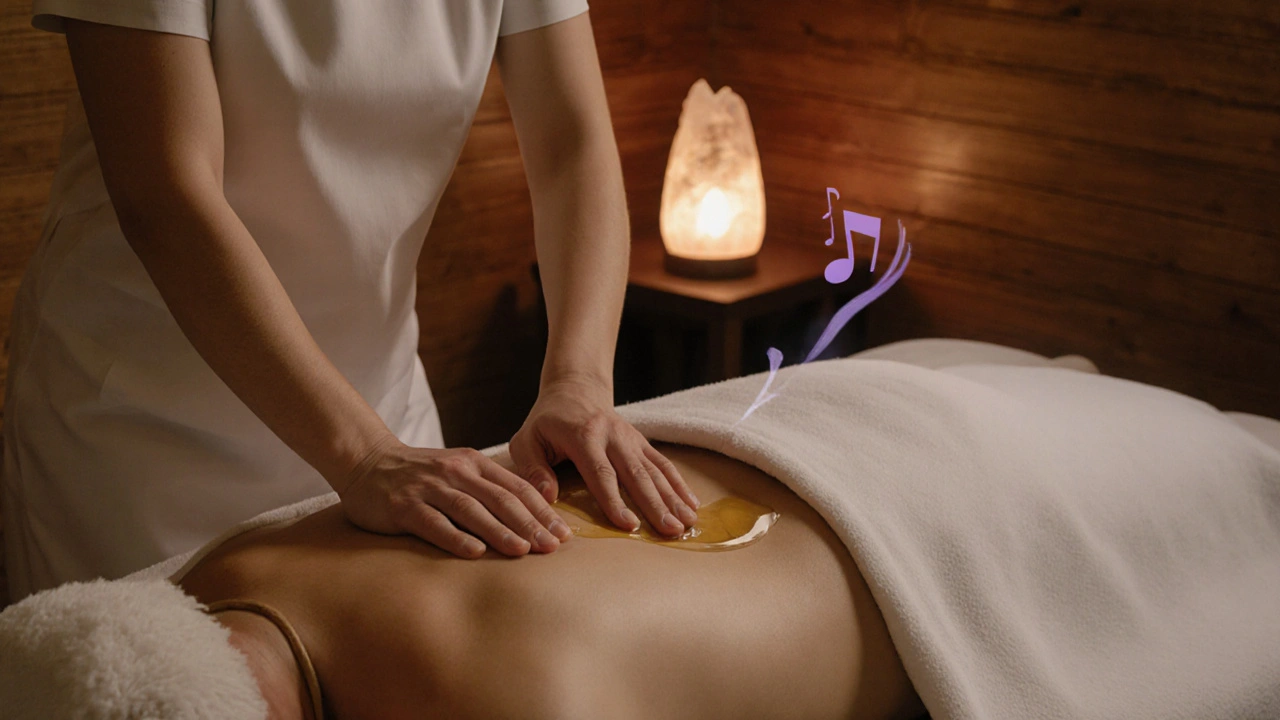Deep Tissue Massage: The Essential Guide for Muscle Recovery

Ever get that lingering ache after a workout or long workday? Deep tissue massage could be your new best friend. It’s not just for athletes—busy parents, desk-workers, and weekend warriors can all use a little help when tight muscles start screaming for attention.
This type of massage targets the deeper layers of muscle and connective tissue. It’s perfect for digging into those stubborn knots and breaking up scar tissue, especially if you’ve tried gentler massages and felt like, “That was nice, but my muscles need more.”
If you’ve never had a deep tissue massage before, it’s normal to wonder if it really helps or what the experience is like. Expect actual pressure and real results—sometimes even a bit of “hurts-so-good.” This isn’t your run-of-the-mill spa day; it’s muscle recovery with purpose.
- Key Points for Muscle Recovery
- Deep Tissue Massage Explained
- Top Benefits You’ll Feel
- How to Book and Prepare
- Safe Session Tips
Key Points for Muscle Recovery
Muscle recovery isn’t just about rest—smart recovery includes things like hydration, sleep, nutrition, stretching, and yes, massage therapy. Deep tissue massage steps in by targeting deep layers of muscle and fascia, where tension and knots like to hide. If you’re aiming to feel better after tough workouts, long days on your feet, or even marathon parenting sessions (trust me, I’ve been there), it helps to know where this massage fits in.
- Deep tissue massage works by using firm pressure and slow strokes. This helps break up scar tissue, reduce inflammation, and increase blood flow.
- Studies out of the University of Illinois found that regular massage can actually help muscles recover faster by up to 30% compared to rest alone.
- Foam rolling, gentle movement, and good nutrition work alongside massage for faster results—think of them as your main squad for healing.
- Post-massage, drinking water helps flush out toxins released during muscle manipulation, which can also reduce soreness the next day.
As Dr. Tiffany Field from the Touch Research Institute says,
“Massage increases circulation, reduces muscle tightness, and supports better healing for active bodies.”
Take a peek at some quick stats on muscle recovery boosters below:
| Recovery Method | Average Recovery Time Reduced (%) | Main Benefit |
|---|---|---|
| Deep Tissue Massage | 25-30% | Relieves deep muscle tension |
| Stretching | 10% | Improves flexibility |
| Hydration | 5% | Aids tissue repair |
So, if you want to bounce back faster—whether it’s from sports or just chasing your kids and dog—consider combining these approaches. Deep tissue massage just happens to be the MVP for tough knots and real relief.
Deep Tissue Massage Explained
If you’ve ever wondered what sets deep tissue massage apart from the usual spa rub-down, here’s the lowdown: it goes after those deep, hidden muscle layers—think the spots that ache when you sit at your desk too long or push yourself at the gym. Unlike the gentle Swedish massage, deep tissue uses slower strokes and serious pressure to work out stubborn knots and chronic tension. Don’t worry, it’s not all pain and no gain—many people walk out feeling lighter and finally able to move freely again.
Masseuses target the inner layers of your muscles and connective tissue (called fascia). That’s why it can get a little intense at times. The main goal is to break up scar tissue and increase blood flow, which actually helps with healing and reduces inflammation. Deep tissue massage can even help with chronic pain issues like lower back pain, neck stiffness, and shoulder tension. A 2014 study in the journal Manual Therapy found that just one session can lower blood pressure and heart rate, especially in folks dealing with stress.
Wondering what techniques the pros use? Here’s a quick rundown:
- Slow, firm strokes that move along muscles and tendons
- Direct pressure using hands, knuckles, elbows, or forearms
- Trigger point work for those tight, painful spots
- Cross-fiber friction to untangle muscle fibers that got stuck together
Here’s a handy comparison that breaks down how deep tissue massage really stacks up against other types:
| Type | Pressure Level | Common Uses | Duration |
|---|---|---|---|
| Deep Tissue | Firm to Very Firm | Muscle pain, injuries, chronic tension | 60-90 min |
| Swedish | Light to Medium | General relaxation, stress relief | 50-60 min |
| Sports Massage | Varies (deep or light) | Performance, recovery, flexibility | 30-60 min |
Deep tissue massage is safe for most people, but it’s smart to check with your doctor if you have any medical conditions, recent injuries, or are pregnant. When in doubt, always ask your massage therapist about what’s right for you and go at your own pace. Your muscles will thank you.

Top Benefits You’ll Feel
Deep tissue massage isn’t just popular for fun—it’s legit for muscle recovery and plenty of other reasons. Here’s what people really notice once they start working regular sessions into their lives.
- Deep tissue massage helps break up those sticky knots (called adhesions), so your muscles move again without that tight, pulling feeling. That means your body bounces back faster from tough workouts or even simple strains.
- Pain relief is huge. Studies from the Journal of Clinical Psychiatry say deep tissue massage can drop chronic pain scores by up to 30%. It’s especially handy for lower back pain, neck tension, or pain from overuse at work (hello, desk jobs!).
- Blood flow gets a serious upgrade. More circulation means more oxygen, which helps your muscles heal and recover—kind of like speeding up a repair job at home.
- Stress practically melts away after a few minutes. The pressure tells your body to relax and your nervous system chills out, so you end up sleeping better and snapping less at home (kids and dogs will thank you!).
- Scar tissue softens over time, especially after surgeries or injuries like sprained ankles or sore shoulders. This means you’ll have better flexibility and less random pain.
Check out how deep tissue compares to classic Swedish massage when it comes to common benefits:
| Benefit | Deep Tissue Massage | Swedish Massage |
|---|---|---|
| Pain Relief | High (great for chronic and deep pain) | Moderate (good for mild tension) |
| Muscle Recovery | Speeds up healing after workouts | Mainly relaxation |
| Stress Reduction | Effective, but a bit intense | Very relaxing |
| Scar Tissue Breakdown | Strong impact over time | Low impact |
If you’re tired of just "putting up" with the aches, this massage type is a practical fix. And honestly, once you feel the difference, you might wonder why you waited so long to try it.
How to Book and Prepare
Ready to try a deep tissue massage for muscle recovery? Booking is easier than you think, especially if you know what to look for and how to get set for your first session. Here’s a simple walk-through, from picking the right therapist to making sure your experience is smooth.
- Deep tissue massage therapists usually work in clinics, spas, or even gyms. Most let you book online, though plenty still take phone or in-person appointments. Check their website for an up-to-date calendar.
- Read reviews—preferably on Google or platforms like Yelp. Look for feedback that matches your needs, like pain relief or sports therapy. It’s a good sign if people say the therapist listens and customizes pressure.
- Ask about qualifications. In most states, massage therapists need a license; you can even request info on their training and specialties. A massage therapist who’s worked with athletes or chronic pain is often a safe bet if you want results.
Once you’ve picked a place, here’s how to get ready so you get the most out of your session:
- Hydrate. Good hydration helps your body flush out toxins released during the massage. Try to drink an extra glass of water before and after.
- Eat light. You don’t want to show up hungry, but a big meal right before your appointment can make you uncomfortable when laying on the table.
- Avoid caffeine or alcohol in the hours leading up—it can make your muscles more sensitive or make you feel jittery.
- Wear comfy clothing and bring a change if you’re coming from work or the gym. Most clinics ask you to undress to your comfort level; you’ll be covered with sheets during the massage.
- Share your needs. When you arrive, tell the therapist about problem areas, injuries, and the pressure you like. Good communication makes all the difference.
| Booking Method | % of Users |
|---|---|
| Online/Website | 65% |
| Phone Call | 27% |
| Walk-In/Other | 8% |
Pro tip: If you’re new to deep tissue massage, ask for a 60-minute session instead of jumping straight into 90. That’s enough time to work several areas without feeling overwhelmed, and you can always go for longer next time if you want.
Finally, double-check the cancellation policy—plans change, and some places have strict rules. Many require 24-hour notice to avoid a fee. Set yourself a reminder so you’re not caught off guard.

Safe Session Tips
Staying safe—and comfortable—during a deep tissue massage isn’t complicated, but there are a few things you’ll want to know before you hit the table. The right approach means better results and fewer worries.
Start by checking that your massage therapist is licensed. These licenses aren’t just for show; they prove someone’s had real training and knows what they’re doing. For example, in most U.S. states, therapists need anywhere from 500 to 1,000 training hours to get certified. That’s a lot of practice making sure you don’t leave in worse shape than you arrived.
- Deep tissue massage isn’t supposed to be torture. If something feels way too painful, speak up right away. Communication makes all the difference and good therapists want your feedback.
- Tell your therapist about any injuries, surgeries, or health problems, even if they seem unrelated. This helps them avoid problem spots and adjust the pressure to what’s right for you.
- Drink plenty of water before and after your session to help flush out any toxins and reduce the chance of soreness.
- If you’re pregnant, have a bleeding disorder, or take blood thinners, skip deep tissue massage (or get your doctor’s okay first). Safety always comes before muscle relief.
- It’s normal to feel a little sore a day or two after your massage, but sharp pain or significant bruising means it’s time to call your therapist—and maybe a doctor.
| Action | Why It's Important | Quick Tip |
|---|---|---|
| Check therapist’s license | Reduces risk of injury or improper technique | Ask to see their certification at your first visit |
| Share health history | Helps your therapist avoid risky areas | Write down meds & conditions before you go |
| Hydrate before & after | Flushes out muscle byproducts and eases soreness | Drink an extra glass of water before and after |
| Report unusual pain | Prevents serious injury | Speak up during the session—don’t tough it out |
One last thing: trust your gut. If an environment or therapist feels off, you never have to go through with it. Your comfort and peace of mind matter most—and that’s the foundation for muscle recovery that actually works.


